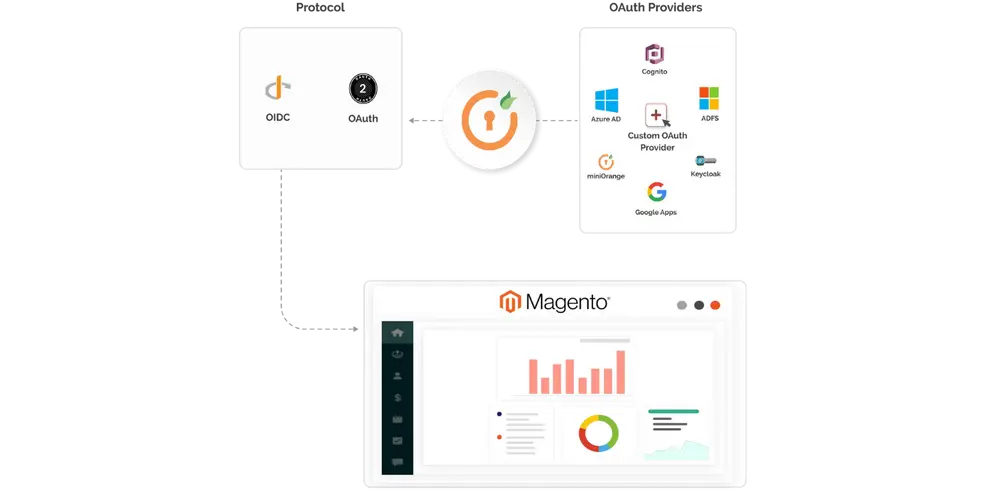If you're an e-commerce store owner and your online store is built on Adobe Commerce (formerly Magento), you know how important it is to provide a seamless and secure login for your backend users (admins) and Frontend users (customers). Adobe Commerce, formerly known as Magento, is a highly customizable and robust e-commerce platform that has evolved to meet the growing needs of businesses worldwide.
One of the best ways to achieve Single Sign-On is by implementing Magento 2 SSO for your store. Magento SSO extension by miniOrange allows your users to log in into your Magento store using Identity Provider (IDPs) credentials. Let's see how you can easily implement SSO on your Adobe Commerce store using the miniOrange SSO extension.
Understanding Single Sign-On (SSO)
Single Sign-On (SSO) allows your users to login into various applications with a single set of login credentials. Your users only need to remember one set of login credentials to access various systems and applications. This not only enhances the user experience by reducing the number of times they have to log in but also increases security by minimizing password exhaustion.
Why Choose miniOrange SSO Extension for Magento 2?
miniOrange is a well-known name in identity and access management, offering a robust SSO solution for Magento 2. Here are a few reasons why miniOrange stands out:
- miniOrange SSO extension for Magento is easy to install and configure, even if you're not a tech expert.
- Supports various protocols like SAML, OAuth, and JWT, ensuring compatibility with different and every identity provider out there.
- Supports both Backend (Admins) and Frontend (Customers) users.
- Support for multi-store and multi-site Magento environments.
- Allows you to easily integrate multiple Identity Providers that facilitate your users to login into Magento using different providers credentials.
- Auto creates users in Magento if the user is not already present in the Magento database.
- Force authentication and auto-redirect your users to login via their Identity Provider credentials only.
- Seamless support for all three versions of Adobe Commerce (Magento) i.e Community, Enterprise, and Cloud versions.
- Frequent updates according to the latest security patches and Magento versions.
- Advance Attribute Mapping with support for custom attribute mapping to easily map the attributes coming from your Identity Provider.
- Advance Role Mapping.
- Additional support for features like multi-factor authentication (MFA) & OTP verification to secure your store and verify every user coming to your store.
- Detailed documentation and support make the setup process easy and straightforward.
What are the benefits of Implementing SSO for your Magento 2 Store?
- Enhanced User Experience: SSO allows your customers to access your Magento 2 store with a single set of credentials, streamlining the login process. This convenience reduces the hassle of remembering multiple usernames and passwords, leading to a smoother and more enjoyable shopping experience.
- Increased Security: By centralizing authentication, SSO can enhance security. It reduces the risk of weak passwords being used across multiple sites, lowers the chances of phishing attacks, and allows for the implementation of stronger authentication methods, such as multi-factor authentication (MFA).
- Improved Conversion Rates: Simplifying the login process can reduce friction at critical points in the customer journey, such as account creation and checkout. This ease of access can lead to higher conversion rates and fewer abandoned carts, increasing sales and revenue.
- Streamlined User Management: For admins, SSO simplifies user management by centralizing the authentication process. This makes it easier to manage user access, enforce security policies, and integrate with other systems, ultimately saving time and reducing overhead.
How to set up SSO for your Magento 2 store (In three easy steps)?
- Download the miniOrange SSO extension for Magento 2 from the Magento Marketplace and install it on your Magento site. You can follow the complete installation video guide to easily install the extension.
- After installation, configure the Single Sign-On application in your Identity provider by configuring your Magento store URL as a Redirect / Callback URL on IDP and bring back the Client ID and Client secret from your IDP side.
- Configure Client ID and Client secret received from IDP in Magento 2 SSO extension to establish a successful Single Sign-On connection.
You can check out the complete step-by-step setup guides with different Identity Providers from here.
Best Practices for SSO Implementation
Implementing SSO includes more than just technical setup. Adopting best practices ensures a smooth and secure integration:
Security Best Practices
- Use Strong Authentication Methods: Ensure that your IdP supports strong authentication methods such as multi-factor authentication (MFA). MFA adds an extra layer of security, making it more difficult for attackers to gain unauthorized access.
- Regularly Update Certificates: Periodically update the public certificates used by your IdP to sign SSO responses. This ensures continued trust in the authentication process.
- Monitor for Suspicious Activities: Regularly monitor for suspicious login activities and take swift action if any anomalies are detected. This includes setting up alerts for unusual login patterns or failed login attempts.
User Experience Best Practices
- Communicate with Users: Inform users about the new SSO system and provide clear instructions on how to use it. This helps in reducing confusion and ensures a smooth transition.
- Provide Support Resources: Offer support resources such as FAQs, user guides, and a helpdesk to assist users with any issues they might encounter during the SSO login process.
- Gather Feedback: Collect feedback from users to identify any issues or areas for improvement. Use this feedback to refine the SSO implementation and enhance the user experience.
Technical Best Practices
- Regular Backups: Perform regular backups of your Magento store and SSO configuration settings. This ensures that you can quickly restore your system in case of any issues.
- Scalable Infrastructure: Ensure that your infrastructure can handle the increased load that may result from implementing SSO. This includes having adequate server resources and optimized database performance.
- Testing and Staging: Always test changes in a staging environment before deploying them to production. This helps in identifying and fixing any issues without affecting live users.
Closing Notes
Implementing SSO in your Magento 2 store using the miniOrange SSO extension can highly improve user experience and enhance security. You can seamlessly provide your users with a convenient and secure way to access your store. Give miniOrange Magento 2 SSO extension a try and see the difference it can make for your business.
Additional Resources
Author





Leave a Comment